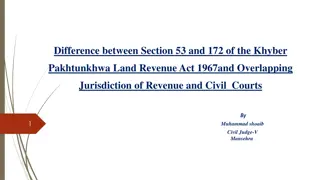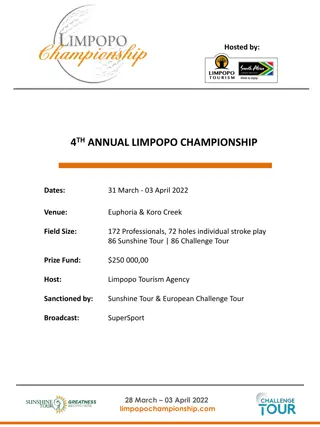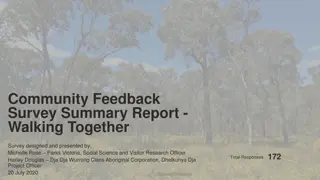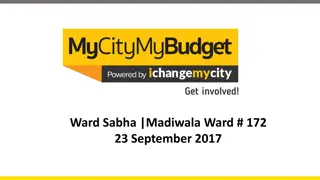
Lean UX Framework and Agile Principles in Systems Development
This lecture covers the Lean UX Framework, stakeholders, personas, Agile principles, user experience (UX), and the evolution of systems development methodologies. It emphasizes the importance of continuous assessment tasks, catching up on missed material, and collaboration in Agile development. Lean UX principles, including maximizing user value and removing waste, are highlighted alongside the Agile principles favoring individuals, collaboration, working software, and customer feedback. The importance of user experience, usability, emotional impact, and meaningful design is also discussed.
Download Presentation

Please find below an Image/Link to download the presentation.
The content on the website is provided AS IS for your information and personal use only. It may not be sold, licensed, or shared on other websites without obtaining consent from the author. If you encounter any issues during the download, it is possible that the publisher has removed the file from their server.
You are allowed to download the files provided on this website for personal or commercial use, subject to the condition that they are used lawfully. All files are the property of their respective owners.
The content on the website is provided AS IS for your information and personal use only. It may not be sold, licensed, or shared on other websites without obtaining consent from the author.
E N D
Presentation Transcript
1 INFS 1026 Systems Requirements and User Experience - SRUX Lecture 2: Lean UX Framework, Stakeholders and personas
2 Reminders It is your responsibility to ensure the continuous assessment tasks are completed 20% is two grade bands It is your responsibility to catch up on missed tasks and lecture material Recordings are below the Zoom details to play or download Extensions will not be enabled unless the individual has a valid medical certificate Extensions must be approved you cannot take them for granted. You have a week to revise the materials covered in the lecture and do the task
4 Systems Development Evolution According to Kaley (2022) Waterfall: Phases of work flowing in sequence toward project completion Agile: Collaboration and embracing change are more important than following a plan Lean: Maximizing user value through continuous experimentation and removing waste Waterfall has its place for specific types of projects
5 Agile Principles Recap 4 major principles of agile development Favour individuals and interactions over processes and tools Team engagement and collaboration by people with diverse knowledge Favour working software over comprehensive documentation Fast feedback from the on site customer to determine viability of potential solutions Favour customer collaboration over contract negotiation Customer collaboration vital to the success of the system Favour responding to change over following a plan Discover what is wrong in initial designs as soon as possible through collaboration Gothelf & Seiden 2016
6 User Experience User experience (UX) is an extension of design thinking All end-user interaction with the company, services and products. (Norman & Nielsen 1998) Design that suits the user of the system Usability Usefulness Emotional impact Meaningfulness Hartson & Pyla 2019
7 Lean UX
8 Lean UX Framework Principles Three main groupings Team construction Cross functional teams Small, dedicated and co-located Self sufficient and empowered Problem focused Gothelf & Seiden 2016
9 Lean UX Framework Principles Culture of learning and curiosity Move from doubt to certainty through validating assumptions Outcomes not output, create a meaningful and measurable change in customer behaviour Remove waste / focus on what matters, the outcomes Shared understanding, the collective knowledge of the team No individual stars, no big egos who don t share, want to stand out Permission to fail, safe environment where experimentation is encouraged -> creativity and innovation or failure, failure -> learning Gothelf & Seiden 2016
10 Lean UX Framework Principles Process Small units helps minimise risk, design and validate as you progress Continuous discovery understand what and why about customers from the customers GOOB getting out of the building and test ideas outside of the small team Externalise your work share ideas with the team Making over analysis debate over an idea wastes time Getting out of the deliverables business, learn what features customers react to most Gothelf & Seiden 2016
11 Lean UX Process
12 Stakeholders
13 Stakeholders Stakeholder - definition People, systems or organisations who directly use the system or the information produced by the system User involvement vital to successful system Identify who needs to be involved in research Ensure critical people from each category available to serve as business experts Different interaction and unique perspective with the system and requirements Some requirements may not be obvious or widely known to people in the organisation Satzinger, Jackson & Burd 2016
14 Stakeholders Stakeholders provide valuable information about Requirements of the system Effect of the system on others Systems which need to be interfaced / communicated with Agile methodologies make a distinction between two types of stakeholders for a system System stakeholders Project stakeholders Leffingwell & Behrens 2010
15 System Stakeholders Primary resource for requirements information Classified based on their interaction with the system Identify system stakeholders by asking questions 1. Who directly uses the system? 2. Who uses the results from those who use the system? 3. What systems interact with the system? 4. Who will support / maintain the system? Leffingwell & Behrens 2010
16 System Stakeholders First degree 1. Directly use the system perform create, read, update or delete transactions Interface with data May understand with what other systems the new product will interface Example Students enrol in courses Leffingwell & Behrens 2010
17 System Stakeholders Second degree Who uses the results from those who use the system? Create information from the data in the system Use outputs from the system Example: Using student enrolment data Lecturers / tutors create class lists Students view their timetable Note: stakeholders can be first and second degree stakeholders of a system 2. Leffingwell & Behrens 2010
18 System Stakeholders Second degree What systems interact with the system? Information fed into / received from a secondary system Example: Using student enrolment data Accounting department / accounting system create account reminders or calculate fees due tasks within accounting system performed using information from enrolments 3. Leffingwell & Behrens 2010
19 System Stakeholders Third degree 4. Who will support / maintain the system? Responsible for the maintenance of the system Understand the current system functions and problems Understand what is needed for the new system Provide technical advice / expertise May not be the people who are doing the system development Example SAIBT or Navitas IT department Leffingwell & Behrens 2010
20 System Stakeholders Important IT departments or staff are third degree stakeholders unless the system is one which they use AND maintain When IT tests a system, they do not update the main database Changes using test data only
21 Project Stakeholder Classifications Have an interest in the success of the system Classified based on involvement in the project Keep informed Include management, staff, other affected business units Must know project status and decisions impacting the project status May be decision makers May influence decision makers Need to be consulted Aid in definition or building of the system Subject matter experts, IT specialists Frequent users who understand the current system and additional requirements Leffingwell & Behrens 2010
22 Project Stakeholder Classification Are partners in development Other development teams Analysts Providers of systems requiring an interface to the developed system Are in control of outcomes Make final decisions about the system Executives, release managers Political change -> Impact negatively or support Leffingwell & Behrens 2010
23 Project Stakeholders Multiple Classifications Scenario: Update assessment processes in MOODLE Keep informed: SAIBT management, Board of Directors Be consulted: Moodle consultant, selection of managers, user experts Partners in development: Navitas IT, MOODLE In control of outcomes: Navitas and SAIBT management Change in politics if public funding Leffingwell & Behrens 2010
24 Personas Salazar (016)
25 Personas Help teams understand stereotypical users of the system Focus on needs, experiences, behaviours and goals What they expect from the system What they need to do using the system Pain points when using the old or similar systems Preferences Think about individual tasks from the perspective of a person Often only need one or two personas to represent the key users groups Ray the student Michelle the lecturer Leffingwell & Behrens (2010); Laubheimer (2020) ;Salazar (2021)
26 Example Persona Harley 2015
27 Personas Revisit personas in week 5 Discovery Associate with tasks they perform
28 References Gothelf, J & Seiden, J 2016, Designing great products with agile teams, O Reilly Media, US, ProQuest Ebook Central. Harley, A 2015, Personas make users memorable for product team members, Nielsen Norman Group, viewed 1 March 2022, <https://www.nngroup.com/articles/persona/>. Laubheimer, P 2017, Personas vs. jobs-to-be-done, Nielsen Norman Group, viewed 11 October 2021, <https://www.nngroup.com/articles/personas-jobs- be-done/>. Laubheimer, P 2020, 3 persona types: Lightweight, qualitative and statistical, Nielsen Norman Group, viewed 11 October 2021, <https://www.nngroup.com/articles/persona-types/>. Leffingwell, D & Behrens, P 2010, Agile software requirements: Lean requirements practices for teams, program and the enterprise, 1st Edn, Pearson Education Limited, Upper Saddle River, NJ, pp. 119-133. Salazar, K 2016, What are personas, video, YouTube, November 26, viewed 1 March 2022, < https://www.youtube.com/watch?v=khLWLtxmMGM>. Salazar, K 2017, Bringing personas to agile, video, YouTube, September 9, viewed 1 March 2022, < https://www.youtube.com/watch?v=3ZLDQSFf5j8&list=PLJOFJ3Ok_ids-oEPCltCVtmdDOXiyttpq&index=7>. Satzinger, J, Jackson, RB & Burd, SD 2016, Systems analysis and design in a changing world, 7th edn, Cengage Learning, USA.




















